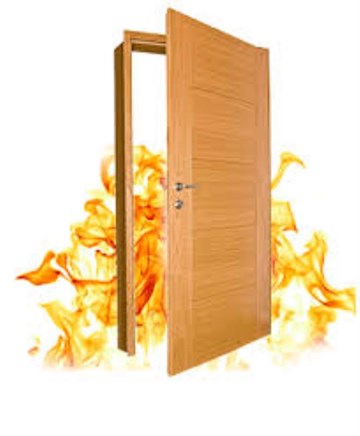
Fire outbreaks are adverse events that create tangible human and financial loss. There are currents efforts being made to improve protective and preventive measures. One of those efforts is the installation of fire doors in our buildings. There are several guidelines put in place by the fire departments across different countries in order to ensure that manufacturer’s produce and install fire doors to comply with basic guidelines needed to ensure the fire door is safe for continuous use.
The British Woodworking Federation (BWF) Certifire scheme provides certain guidelines to ensure compliance on how to maintain a fire door safely. The scheme ensures certification of product via the provision of specification, installation and inspection. Fire door compliance is an act of doing or following the production and installation guidelines stated or provided by regulatory bodies. Manufacturers and users need to comply with those guidelines to ensure safety.
Manufacturers prove to comply with the production guidelines by self-declaration, test certificate and Third-party certification. The responsible person needs ensure fire door compliance. The size of the frame and door needs to be checked if it actually meets the standard of Single (2040mm high X 820 mm wide X 36mm thick) and Double (2040mm high X 920/920mm wide X 45mm thick) requirements.
False fire door compliance results in different risks which are resulting in danger and probable loss of life for the users of the building, danger for emergency services when responding to a fire outbreak, risk of prosecution, loss of property and possession, and risk to personal reputation.
Fire door user compliance can be achieved by understanding the meaning and purpose of the safety feature, and knowing the guidelines that must be followed by manufacturers and users. There are certain checklists the user or third party inspection team will have to check to confirm if the Fire Door is compliant with guidelines. Those checklists and what to look out for are listed below although this list is not exhaustive:
• If the door(s) are fully closing during use (if you notice, the door is to slow to close or slams shut with force there is an error)
• Ensuring a self-closing device is fitted (if required)
• Door handles (Loose or missing)
• Are Intumescent strips and smoke seals fitted and in a good condition
• Is the glazing on the Fire Door secure and fire resisting (not loose, rattling or damaged)
• Door Hinges (Check for loose or missing screws)
• Electromagnetic Door Hold Open Devices (Check they are working)
• Latch or lock (Checking they engage door to frame)
• Frame/Lining (Ensure properly fitted)
• Door Leaf (Style and size are very important)
Fire Door-sets must be supplied as a complete unit and fully fitted up and finished by the manufacturer. Fire certificate must be attached to each of the door components to ensure quality. Resistance rating must be checked properly (FD30 or FD60) for complete compliance. If it’s a fire and smoke control door, the suffix FD30S or FD60S will be found on it.
Fire Door Resistance period (the ability of the door to separate fire for a specific period) is also very important. This states that fire door in a compartment that separates building should be 60 minutes (FD60) while others areas are allowed to use 30 minutes resistant doors (FD30). Signage must be installed on all fire doors that are installed in non-residential buildings. Signs should state "keep closed" or "keep locked" on either side of the door.
Other items to consider are checking open holes or breaks around the door or frame, damage to door or frame, no missing or broken parts, and no field modification to the door assembly. If any of the stated checklists is missing or damaged, safety of the Fire Door is not guaranteed.
Compliance with Fire Door regulations is not always adhered to during production and usage. Since awareness and usage of this preventive device are increasing, it is important for regulators to ensure adherence to the rules especially from the manufacturers point of view. Users need to understand the risks associated with non-compliance. They should ensure they understand the requirement and checklist and properly check in detail before installation or while in use.
























